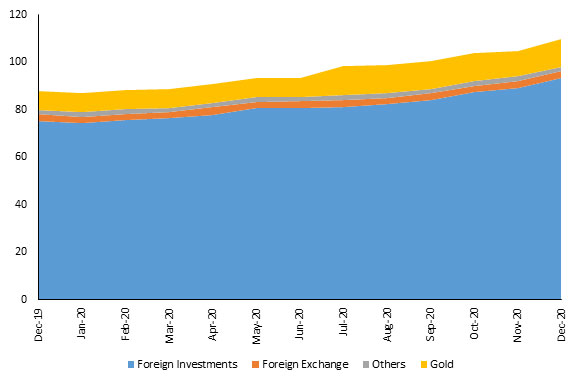January 24, 2021 | 6:37 pm
Introspective By Romeo
L. Bernardo
SOURCE OF DATA: BSP
SOURCE OF DATA: BSP, IMF
SOURCE OF DATA: BSP
Last year, gross international reserves (GIR) surged 25% to end the year
at close to $110 billion. This is remarkable considering the unprecedented
global scale and severity of the COVID-19 crisis.
While short-term capital exited emerging markets as in past crises, this
time around in the Philippines, the balance of payments (BoP) remained in
surplus and even ballooned to nearly $12 billion in the year to November. The
latter mainly reflects collapsed imports as the economy went into recession
and, as tax revenues buckled, increased government borrowings with the overall
external debt estimated to have risen by around $10 billion last year.
In an interview with the editor of the country’s leading business paper
last week, BSP Governor Benjamin Diokno highlighted this atypical but positive
upshot of the crisis that kept depreciation pressure off the peso and allowed
monetary authorities to aggressively cut policy interest rates. He added that
he expects the GIR to continue growing this year, possibly reaching $120
billion.
OUR VIEW
Pre-pandemic, the Philippines already had one of the highest foreign
exchange stockpiles based on the IMF’s assessment of reserve adequacy (ARA).
The ratio of reserves to ARA at end-2019 was at 2, higher than the 1-1.5 ratio
considered adequate and above most countries’ reported ratios. Last year, the
additional reserve buildup unarguably gave economic managers more wiggle room
to manage the crisis, not least by helping to anchor the sovereign’s credit
rating and giving the government continuing access to international capital
markets at relatively tight borrowing spreads. By the end of 2020, GIR could
amply cover over 5.4x short-term debt plus principal payments on medium to long
term loans due in the next 12 months, up from 3.9x at the end of 2019.
Going by this, the GIR will continue to amply cushion any external shock
in the near term. Moreover, given our dimmer view of the economy’s growth
prospects, we think the current account will still register a modest surplus
this year with moderate import growth, while private capital outflows are
unlikely to be as massive as last year, with portfolio flows starting to return
in 4Q20. We note too that although GIR was in large part boosted by increased
government borrowings, these consisted of long-term loans, a significant
portion of which is owed to official creditors who also provided long grace
periods on principal repayment. One downside risk given BSP’s (Bangko Sentral
ng Pilipinas) decision last year to actively trade its gold holdings, is lower
gold prices.
However, holding excess reserves is not without cost. From a
consolidated public sector viewpoint, the collateral value of these highly
liquid assets needs to be weighed against the negative carry associated with
their low returns as well as foregone productivity-enhancing domestic public
investments. As pandemic risks subside with improved health management and the
promise of vaccination, one could argue that keeping such high precautionary
cash is no longer warranted.
Too, with the peso having appreciated by 5% in real, trade-weighted
terms last year, many in policy circles would argue for a more proactive
government response to support the export sector. Realizing that the BSP could
only do so much with its foreign exchange market interventions, the suggestion
is for the government to perhaps forego external commercial market borrowings
altogether. As the argument goes, at a time when the government is looking to
pass more of the burden of spurring economic growth to the private sector, raising
the purchasing power of dollar earners, particularly overseas and BPO workers,
will help significantly in reviving domestic consumption which accounts for
about 70% of GDP. Government may also fret less about the impact on domestic
interest rates of more local borrowings considering last year’s aggressive
monetary easing that injected close to P2 trillion of liquidity into the
financial system, weak loan market (both demand and supply), and a two-year
window to directly tap an additional P280-billion loan from the BSP.
There is thus scope for the government to nudge the GIR down this year
rather than allow it to climb some more. For now, there are no signals that it
intends to do so.
Romeo L. Bernardo was finance undersecretary during the Cory Aquino and
Fidel Ramos administrations. This column was a post to subscribers of
GlobalSource Partners (globalsourcepartners.com) a New York-based network of
independent analysts. He and Christine Tang are their Philippine partners.
romeo.lopez.bernardo@gmail.com



No comments:
Post a Comment